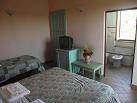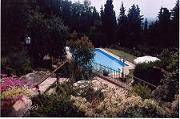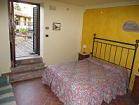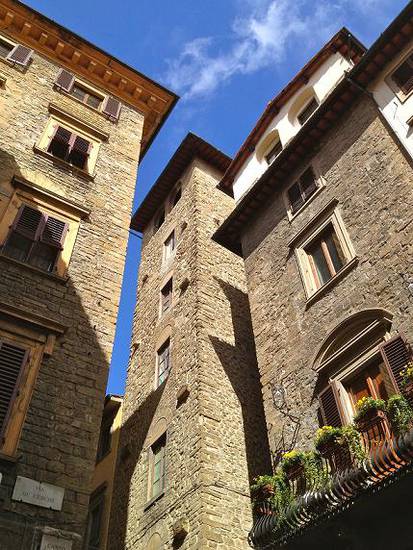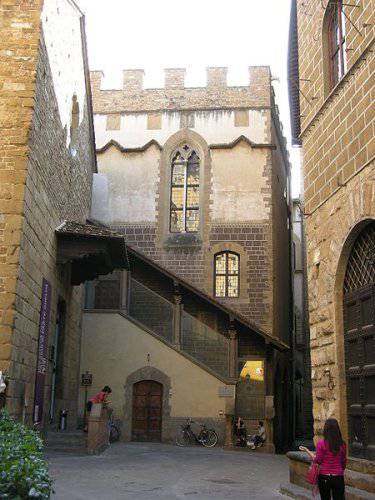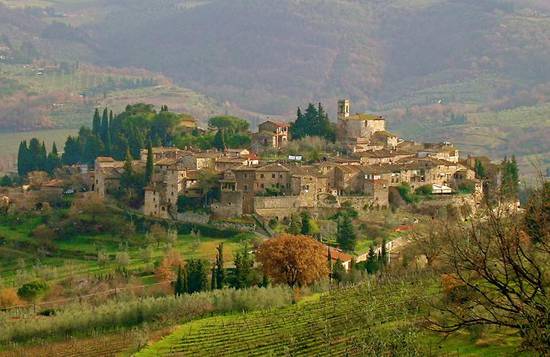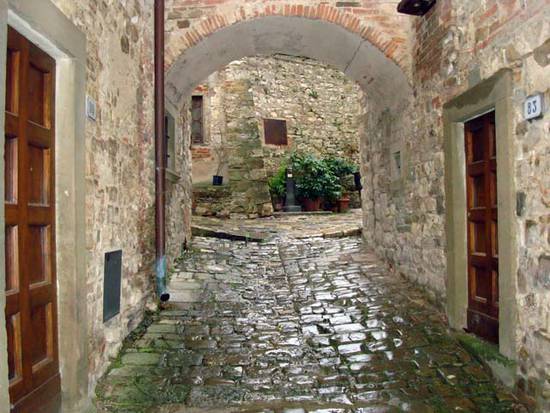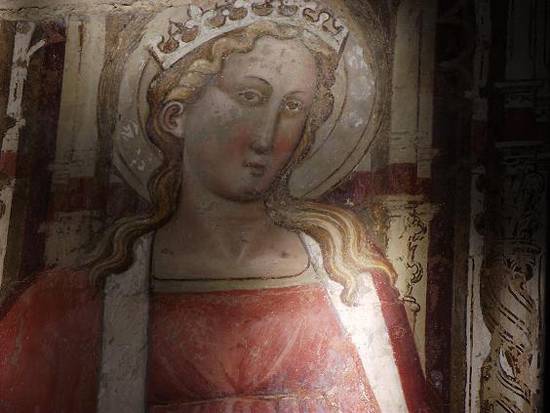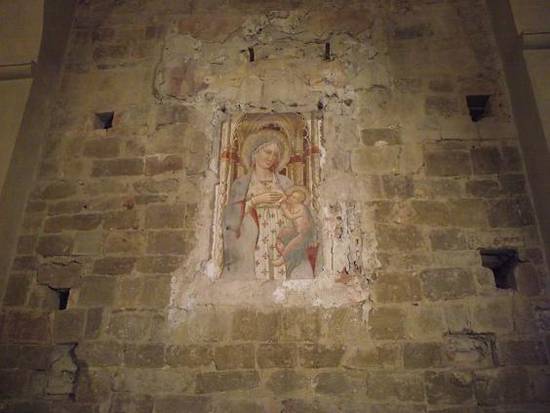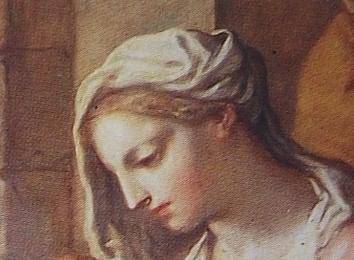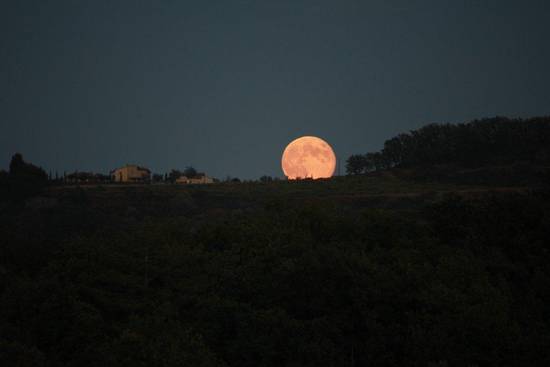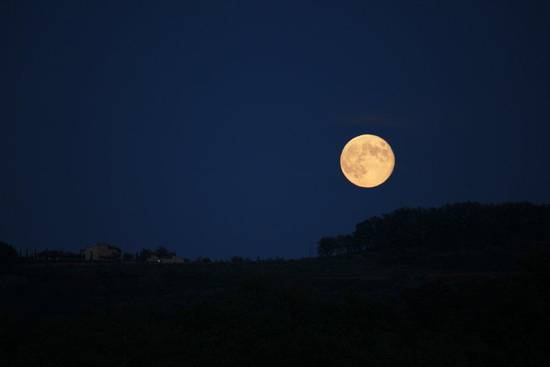Salvino 5 è un appartamento per uso turistico situato nella frazione Montalbino nel comune di Montespertoli (FI). Immersa tra le belle colline del Chianti con vigneti, uliveti e antiche chiesette, è un ottimo luogo per il relax e un ottimo punto di partenza per visitare i luoghi più celebri della Toscana.
Il proprietario vive nel medesimo edificio in cui si trova l'appartamento "Salvino 5". Il cliente potrà usufruire di un giardino a suo uso personale con tavolo, sedie, ombrellone e barbecue. Si accede all'appartamento da un terrazzo in cui si gode la vista di un bosco antistante e della collina con in cima il borgo di Lucardo. L'interno è costituito da un soggiorno/cucina con tv e divano-letto, due camere matrimoniali, un bagno e lavanderia. Sempre dal medesimo terrazzo si accede anche ad una camera tripla indipendente con proprio bagno, tv, e frigorifero. Sia l'appartamnto che la camera indipendente godono della connessione internet Wi-Fi. Si può prenotare il solo appartamento, o la sola camera indipendente, oppure entrambi. Il numero massimo che può ospitare la struttura è di nove persone. Dal retro della casa, tramite delle scale, si discende ad una bella piscina aperta da maggio ad ottobre.
Sempre sul retro c'è un'altra camera matrimoniale chiamata "La Cantinetta", anche essa è indipendente, con proprio bagno, tv e un piccolo spazio esterno. Al contrario del resto della struttura questa camera non ha l'aria condizionata, ma gode in tutta l'estate di una temperatura fresca naturale.
Nel borgo di Montalbino c'è anche un ristorante, mentre nel capoluogo Montespertoli (7km) si trovano negozi vari, banche, ufficio postale e il supermercato.
Salvino 5 is a flat for tourist use in the village of Montalbino, town of Montespertoli (Florence). It immerses os in beautiful Chianti hills, with vineyards, olive groves and old small churches, it's a good place for relax and a good start point to the most famous places of Tuscany.
The owner lives in the same building when there's "Salvino 5" flat. The guest can use a private garden with table, chairs, beach-umbrella and barbecue. The entrance is on a terrace when it's possible to enjoy a view of a wood in front of us and the hill with in the top the village of Lucardo. The flat inside is compounded by a kitchen/living-room with television and divan-bed, two married bedroom, a bathroom and laundry. From same terrace it's possible to entrance to a independent bedroom with a married bed, a single bed, a television, a fridge and bathroom. Flat abd indipendent room have Wi-Fi internet. If possible booking only the flat, or only the independent room, or both. The maximum it can accommodate it'is nine people. From the back of the house there's same steps that they carry to a beautiful swimming pool open from May to October.
On the back of the house there's another married bedroom called "La Cantinetta". Also this one is indipendent with bathroom, tv and a outside table and chairs. Only this room has'nt air-conditionig, but it has a naturale fresh air all summer.
In the village of Montalbino there's a restaurant, and in the main town Montespertoli (7km) there're various shops, banks, post office and the supermarket.
|
Per Firenze il XIII secolo fu sicuramente ricco di eventi politici oltre che di cultura e arte. Fu un secolo di lotte interne tra le fazioni dei Ghibellini e dei Guelfi. Come nacque questa storia già lo sappiamo. Possiamo dire che il culmine delle lotte fu alla metà del secolo, quando i Ghibellini furono espulsi dalla città. Egli tramarono vendetta e alleati con Siena sconfissero la guelfa Firenze nella battaglia di Montaperti del 1260. Firenze ebbe così per alcuni anni un dominio ghibellino con i guelfi che dovettero andarsene, ma i guelfi ebbero la loro rivincita dopo otto anni vincendo presso Colle val d'Elsa un'altra battaglia, stavolta apparentemente definitiva. I ghibellini sconfitti dovettero andarsene e la famiglia più importante, quella degli Uberti, vide le sue case e le sue torri rase al suolo e in quell'ampio spazio si formò l'attuale Piazza della Signoria.
In realtà ci fu negli anni '80 di quel secolo un nuovo rinvigorimento dei ghibellini. Grazie ad una congiunzione favorevole nella politica internazionale i ghibellini ottennero di poter rientrare nelle città in cui erano stati espulsi come fu anche a Firenze. Ad approfittarsi di questa nuova situazione fu il popolo laborioso che, facendosi rappresentare dai ghibellini, premeva di vedersi riconoscere un peso nella politica cittadina che continuava a rimanere nelle mani della vecchia aristocrazia (va detto che la lotta tra Ghibellini e Guelfi non era stato altro fino ad allora che una lotta tra due consorterie di potenti famiglie di origine aristocratiche). Questo nuovo volto del ghibellinismo fiorentino portò dei frutti: tra il 1283 e il 1284 furono fatte delle modifiche nella costituzione come la creazione del collegio dei Sei Priori (che rappresentavano le sei corporazioni più importanti), la possibilità di alcuni rappresentanti del popolo di entrare nel consiglio del podestà e la creazione di reparti armati.
Successivamente il partito Ghibellino sarà definitivamente sconfitto, almeno per quanto riguarda la storia toscana, con la Battaglia di Campaldino del 1289, ma la tensione tra aristocratici e popolo a Firenze non cessò. Non potendo più sventolare il vessillo dei Ghibellini il popolo cercò nuove vie e nuovi leader. E' un leader veramente importante nella storia di Firenze fu Giano della Bella che nel 1293 riuscì a varare dei provvedimenti rivoluzionari: gli Ordinamenti di Giustizia. Con queste nuove leggi tutti i cittadini fiorentini che volevano entrare in politica erano obbligati ad essere iscritti ad una corporazione. Quindi anche i vecchi aristocratici che vivevano di rendita se volevano continuare ad avere un peso nella politica cittadina furono costretti ad iscriversi e mettere in piedi una attività lavorativa, anche se solo di facciata. Non solo, fu istituita la figura del Gonfaloniere di Giustizia, eletto dai priori e quindi rappresentate del popolo. Egli andò ad affiancare il Podestà, ma ben presto lo surclassò e il Gonfaloniere di Giustizia divenne il nuovo capo dello stato. Il Podestà aveva rappresentato l'antica aristocrazia, veniva da fuori città per garantire la neutralità tra le fazioni delle varie potenti famiglie aristocratiche cittadine; il Gonfaloniere rappresentava il popolo delle corporazioni, era un fiorentino, non importava che venisse da fuori, non ci sarebbero dovuti essere fazioni nemiche perché le corporazioni collaboravano tutte insieme per il bene della città. Firenze era diventata autosufficiente con un governo maturo, responsabile, frutto della volontà della corporazioni.
In realtà ci furono altre tensioni interne, seguirono altre lotte, altre epurazioni, ma Firenze ormai aveva svoltato una pagina della sua storia ed era entrato nel XIV secolo.
Florence to the thirteenth century was certainly full of political events as well as culture and art. It was a century of infighting between factions of the Ghibellines and Guelph. How born the story we already know. We can say that the culmination of the struggle was in the middle of the century, when the Ghibellines were expelled from the city. He plotted revenge and allies with Siena defeated the Guelph Florence in the battle of Montaperti in 1260. So Florence had for a few years a domain Ghibelline with Guelph who had to leave, but the Guelph had their revenge after eight years winning at Colle val d'Elsa another battle, this time apparently final. The Ghibellines defeated had to leave and the family more important, Uberti, saw its houses and its towers destroyed in that vast space that formed the current Piazza della Signoria.
In reality there was in the 80s of this century a new invigoration of the Ghibellines. Thanks to a favorable conjunction in international politics Ghibellines got to be able to return in the cities in which they were expelled as he was also in Florence. To take advantage of this new situation was that the hard-working people, being represented by the Ghibellines, was anxious to be given a weight in city politics that still remained in the hands of the old aristocracy (it must be said that the fight between Guelfi and Ghibellines had been nothing up then a fight between two factions of powerful aristocratic-origin families). This new face of Ghibellinism Florentine brought fruit: between 1283 and 1284 were made of the changes in the constitution as the creation of the College of the Six Priors (representing the six major corporations), the possibility of some representatives of the people entering the council of the Podesta and the creation of armed units. Then the Ghibelline party will be finally defeated, at least for the Tuscan history, with the Battle of Campaldino in 1289; but the tension between aristocrats and people in Florence did not cease. No longer able to wave the banner of the Ghibellines the people sought new ways and new leaders. A very important leader in the history of Florence was Giano della Bella, who in 1293 was able to launch the revolutionary measures: the Ordinances of Justice. With these new laws all Florentine citizens who wanted to enter politics were required to be registered to a corporation. So even old aristocrats who lived annuity if they wanted to continue to weigh in city politics were forced to register and set up a work, even if just a facade. Not only that, it was established the figure of Gonfaloniere di Giustizia, elected by the priors represented the people. He began by support the Podesta, but soon he outclasses him and the Gonfaloniere di Giustizia became the new head of state. The Podesta had represented the old aristocracy, came from out of town to ensure neutrality between the various factions of the powerful aristocratic families in the town; Gonfalonier represented the people of the corporations, was a Florentine, no matter who came from outside, there should have been warring factions because corporations collaborating together for the good of the city. Florence had become self-sufficient with a government mature, responsible, result of the will of the corporations.
In reality there were other internal tensions, followed other struggles, other purges, but Florence now had turned a page in its history and was entered in the fourteenth century. |
|
Nel comune di Greve in Chianti c'é un borgo medioevale fortificato che merita di essere visitato: Montefioralle, che un tempo si chiamava Monteficalle. E' costituito al centro da un cassero scapezzato ridotto ad abitazione civile. Da esso parte una strada che gira intorno e dalla quale si dipanano vicoletti che tornano tutti al cassero. L'architettura è omogenea, dal sapore antico in cui si stacca la chiesa parrocchiale di Santo Stefano. Il tutto racchiuso in delle mura da cui si aprono tre porte.
Durante la sua storia Montefioralle è passata di mano a diversi proprietari, la sua origine forse è longobarda e la sua posizione era strategica in quanto controllava la via che univa il Valdarno Superiore con le valli a sud di Firenze, cioè la Valle della Greve, la Valle della Pesa e la Valle dell'Elsa. Alle pendici della collina su cui sorge il borgo un tempo c'era il luogo del mercato che sviluppatosi è diventata la moderna Greve in Chianti, attuale capoluogo comunale.
All'interno delle mura c'è una abitazione che apparteneva alla famiglia da Verrazzano e c'è chi dice che il famoso navigatore Giovanni da Verrazzano sia nato proprio qui. In the municipality of Greve in Chianti there is a fortified medieval town that deserves to be visited: Montefioralle, which was once called Monteficalle. It's formed at the center of a mold reduced to a private house. From this one start a road that goes around and from which unfold alleys all returning to formwork. The architecture is homogeneous, antique flavor that comes off the parish church of Santo Stefano. All wrapped up in the walls of which there are three doors.
|
|
L'interno della pieve di San Lazzaro è divisa in tre navate da pilastri. L'utilizzo dei pilastri è tipica delle chiese della diocesi di Firenze, ed è curioso osservare che a pochi chilometri, aldilà dell'Elsa, in territorio della diocesi di Volterra, le navate sono divise sempre con colonne come possiamo vedere per esempio nella pieve di Santa Maria a Chianni, o alla pieve di Coiano. Invece nella pieve di San Pietro in Mercato, diocesi di Firenze, la divisione interna è affidata a pilastri come a San Lazzaro. Una cosa che colpisce all'interno della pieve è la verticalità dell'abside centrale, sembra quasi eccessiva. In realtà un tempo si ergeva un presbiterio rialzato che proporzionava le dimensioni dell'abside. Interessanti sono i resti di una cripta che sono rinvenuti durante recenti restauri. Nella cripta si accedeva da delle scale laterali incassati nel pavimento e l'interno era tripartita con tre piccole absidi.
Dal punto di vista architettonico si può dire che la pieve di San Lazzaro è sicuramente la più interessante della Valdelsa.
Inoltre troviamo dei resti di affreschi su alcuni pilastri realizzati da Cenni di Francesco di ser Cenni raffiguranti busti di santi e inoltre su una parete, sempre del medesimo pittore, abbiamo una Madonna che allatta il bambino. Cenni era un pittore molto attivo nella campagna fiorentina, opere sue si trovano in altre chiese nei dintorni e tra essi anche nella chiesa di San Giusto a Montalbino ove era stato realizzato un trittico oggi al Museo di Arte Sacra di Montespertoli. Anche in quel trittico troviamo la Madonna che allatta il Bambino, una iconografia molto amata alla fine del XIV secolo.
The interior of the pieve of San Lazzaro is divided into three naves by pillars. The use of the pillars is typical of the churches of the diocese of Florence, and it is curious to note that a few kilometers, beyond the Elsa river, in the diocese of Volterra, the naves are divided by columns always as we see for example in the pieve of Santa Maria in Chianni, or the pieve of Coiano. Instead, in the pieve of San Pietro in Mercato, in the diocese of Florence, the internal division is headed by pillars as in San Lazzaro. One striking inside of the church is the verticality of the central, seems excessive. Actually once it stood a raised presbytery that proportioned the size of the apse. Interesting are the remains of a crypt that are discovered during recent renovations. The crypt was accessed by stairs side recessed in the floor and the inside was tripartite with three small apses.
From the architectural point of view it can be said that the parish of San Lazzaro is certainly the most interesting of the Val d'Elsa.
|
|
La chiesa di Santa Maria a Torre si trova poco fuori da Montespertoli, sulla via che porta a Lucardo. Faceva capo a questa chiesa uno dei tanti popoli rurali del piviere di San Pietro in Mercato costituito da case coloniche sparse nel territorio. Nonostante la piccola chiesa di Santa Maria sia stata rimaneggiata nel corso dei secoli fino all'ultimo intervento del secolo scorso, conserva ancora sulla facciata due stemmi in pietra raffiguranti le armi della famiglia Machiavelli di cui l'edificio era sotto la tutela di un patronato. Il patronato dei Machiavelli sulla chiesa ebbe inizio nel 1393 e si affiancò ad esso anche il patronato dei Capitani di Parte Guelfa nel 1437. Lo stemma dei capitani doveva sovrastare i due dei Machiavelli al centro della facciata, ma è andato perso. Ce ne uno invece all'interno della chiesa, su un tabernacolo in pietra serena a destra dell'altare maggiore. All'interno inoltre sono conservati due terrecotte invetriate di Giovanni della Robbia raffiguranti una un Angelo con Pergamena, e l'altra un tondo con lo stemma dei Machiavelli circoscritto da una ghirlanda di foglie e frutti.
All'interno c'erano anche tre dipinti oggi custoditi nel Museo di Arte Sacra. Uno di essi è una Adorazione dei Magi con una composizione geometrica molto evidente a "V". La testa canuta del Re Magio più vecchio, prostrato ai piedi del Bambino, costituisce il vertice inferiore della "V". I due bracci della lettera che si elevano in alto sono a destra i volti dei componenti della Sacra famiglia, a sinistra gli altri due Magi. Quindi in questo quadro si nota la rigorosa geometria; la ricchezze delle vesti dei Magi, soprattutto quello prostrato a terra che colpisce particolarmente l'occhio dell'osservatore; i colori tenui del cielo e dello sfondo; il rudere alle spalle della Sacra Famiglia.
La tela fu donata alla parrocchia nel 1802 dal nuovo prete, certo don Gaetano Ariani, che prese possesso della chiesa in quell'anno e dal padre del prete, Giobatta Ariani. Lo sappiamo grazie ad una scritta che si trova sul retro della tela e in questa scritta si dice che il pittore è il fiorentino Giovanni Camillo Sagrestani vissuto a cavallo tra '700 e '800.
In realtà, dopo alcune esposizioni in delle mostre in cui il dipinto è stato osservato da critici d'arte, la maggioranza della critica odierna è concorde nel vedere la mano di un altro artista, quella di Niccolò Bambini: veneziano vissuto cento anni prima di Sagrestani. Bambini fu un allievo del Tiepolo e la sua pittura è pervasa dal tipico colorismo veneto come del resto si può osservare in questo dipinto di Santa Maria alla Torre. Sono evidenti inoltre somiglianze molto stringenti con opere del Bambini eseguite in affresco nel palazzo arcivescovile di Udine. Ma perché la scritta sul retro indica il nome di Sagrestani? Forse nel 1802 si era già persa la conoscenza dell'esecutore, quindi fu un errore; oppure i due committenti, il padre e il figlio Ariani, con malizia vollero far credere che avessero commissionato appositamente un dipinto di un noto pittore fiorentino per la chiesa della Torre, un pittore conosciuto all'epoca nelle campagne fiorentine, quindi molto popolare, invece di aver acquistato un quadro "riciclato" di un perfetto sconosciuto come poteva essere qui nelle campagne toscane un pittore veneto.
The church of Santa Maria a Torre is located just outside Montespertoli, on the road leading to Lucardo. Was headed by this church one of the many rural peoples of piviere of San Pietro in Mercato consists of farmhouses scattered throughout the territory. Despite the small church of Santa Maria has been altered over the centuries until the last intervention of the last century, still preserves two coats of arms on the facade in stone depicting the arms of the Machiavelli family of which the building was under the protection of patronage. The patronage of Machiavelli on the church began in 1393 and was joined to it also the patronage of the Captains of the Guelph in 1437. The coat of arms of the captains had to block out two of Machiavelli in the middle of the front, but was lost. There one instead inside the church, a tabernacle in sandstone on the right of the main altar. Inside also it houses two glazed terracotta by Giovanni della Robbia depicting an angel with a parchment, and one substantial a round with the crest of Machiavelli circumscribed by a garland of leaves and fruits.
Inside there were three paintings now kept in the Museum of Sacred Art. One of them is an Adoration of the Magi with a geometric "V" composition very obvious. The white head of older Wise Man, prostrate at the feet of the Child, is the lower vertex of the "V". The two arms of the letter that rise at the top are on the right the faces of the members of the Holy Family, on the left the other two Magi. So in this context we see the rigorous geometry; the riches of the clothes of the Magi, especially the one prostrate that particularly affects for eye of the observer; the soft colors of the sky and background; behind the ruins of the Holy Family.
The painting was donated to the parish in 1802 by the new priest, a certain Don Gaetano Ariani, who took possession of the church in that year and the father of the priest, Giobatta Ariani. We know this thanks to an inscription on the back of the canvas, and this written said that the painter is the Florentine Giovanni Camillo Sagrestani lived between '700 and '800.
In reality, after a few shows in the exhibitions where the painting was seen by art critics, most critics today is unanimous in seeing the hand of another artist, that of Niccolò Bambini: Venetian lived a hundred years before Sagrestani. Bambini was a pupil of Tiepolo and his painting is imbued with the typical Venetian coloring as indeed can be seen in this painting of Santa Maria a Torre. Are obvious similarities also very strict with the Bambini's works performed in fresco in the archbishop's palace of Udine. But why the writing on the back indicates the name of Sagrestani? Perhaps in 1802 he had already lost the knowledge of the performer, so it was a mistake; or the two clients, the father and son Ariani, maliciously wanted to believe that they had a specially commissioned painting by a famous Florentine painter for the church of Torre, a painter known at the time in the Florentine countryside, so very popular, instead of purchasing a framework "recycled" to a complete stranger as he could be, here in the Tuscan countryside, as a Venetian painter.
|

CONTATTI



